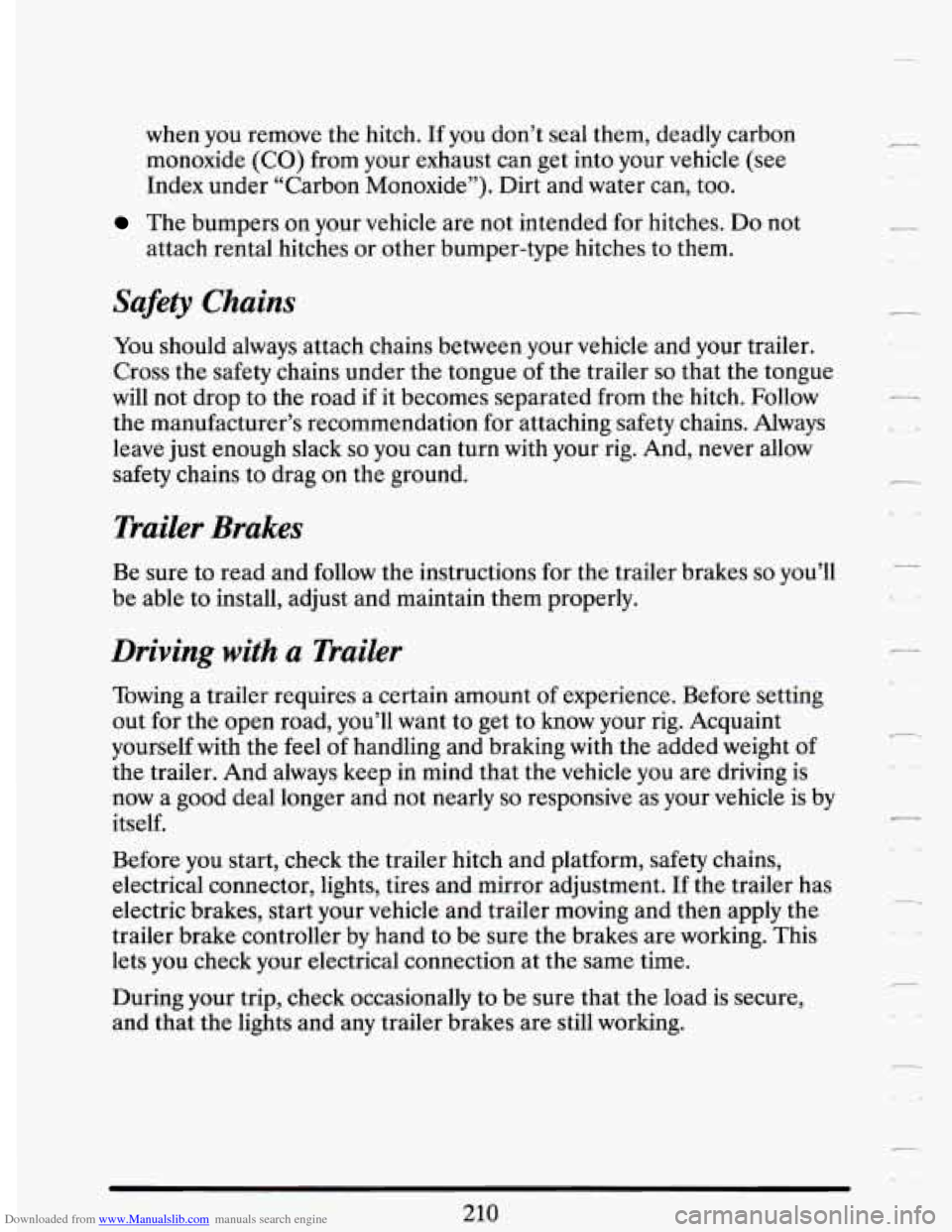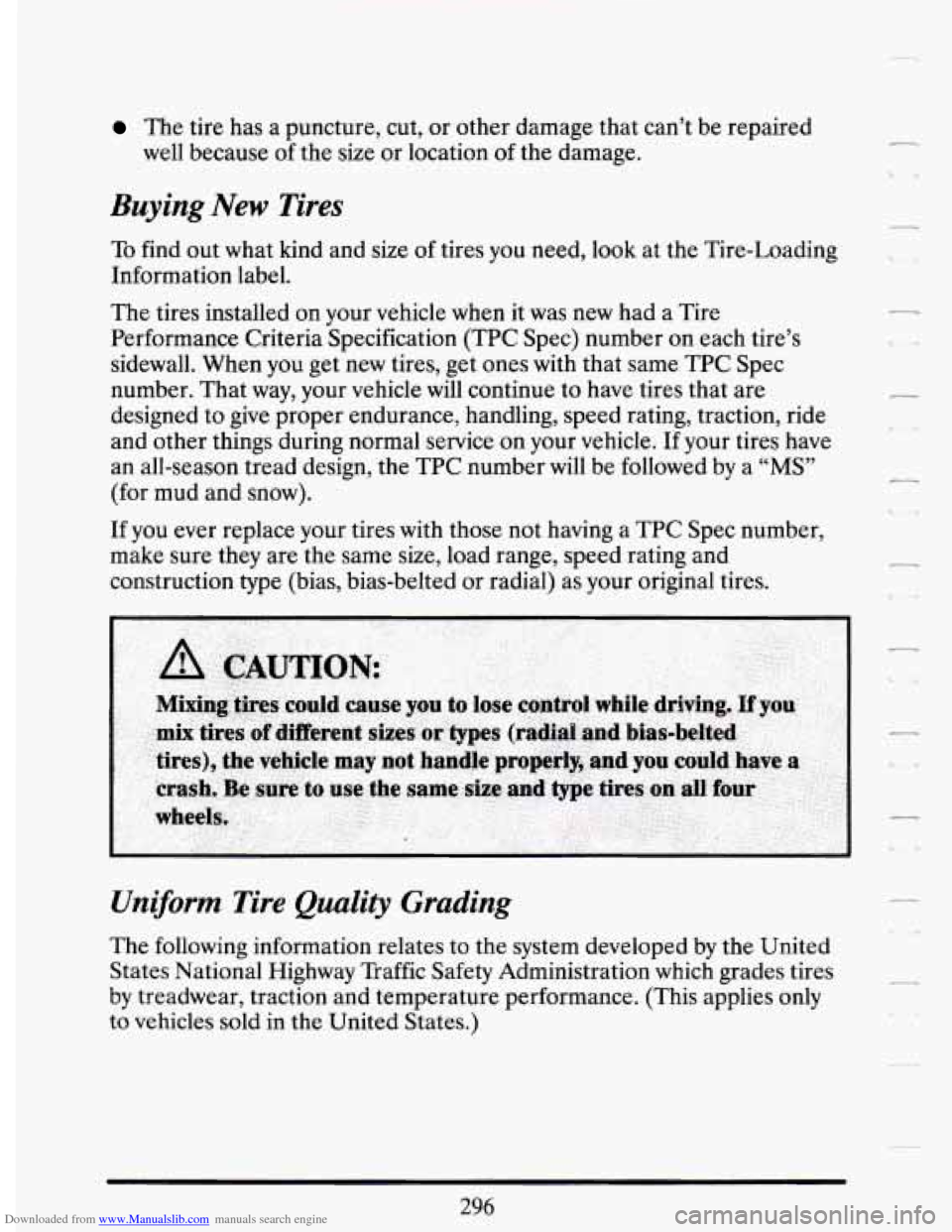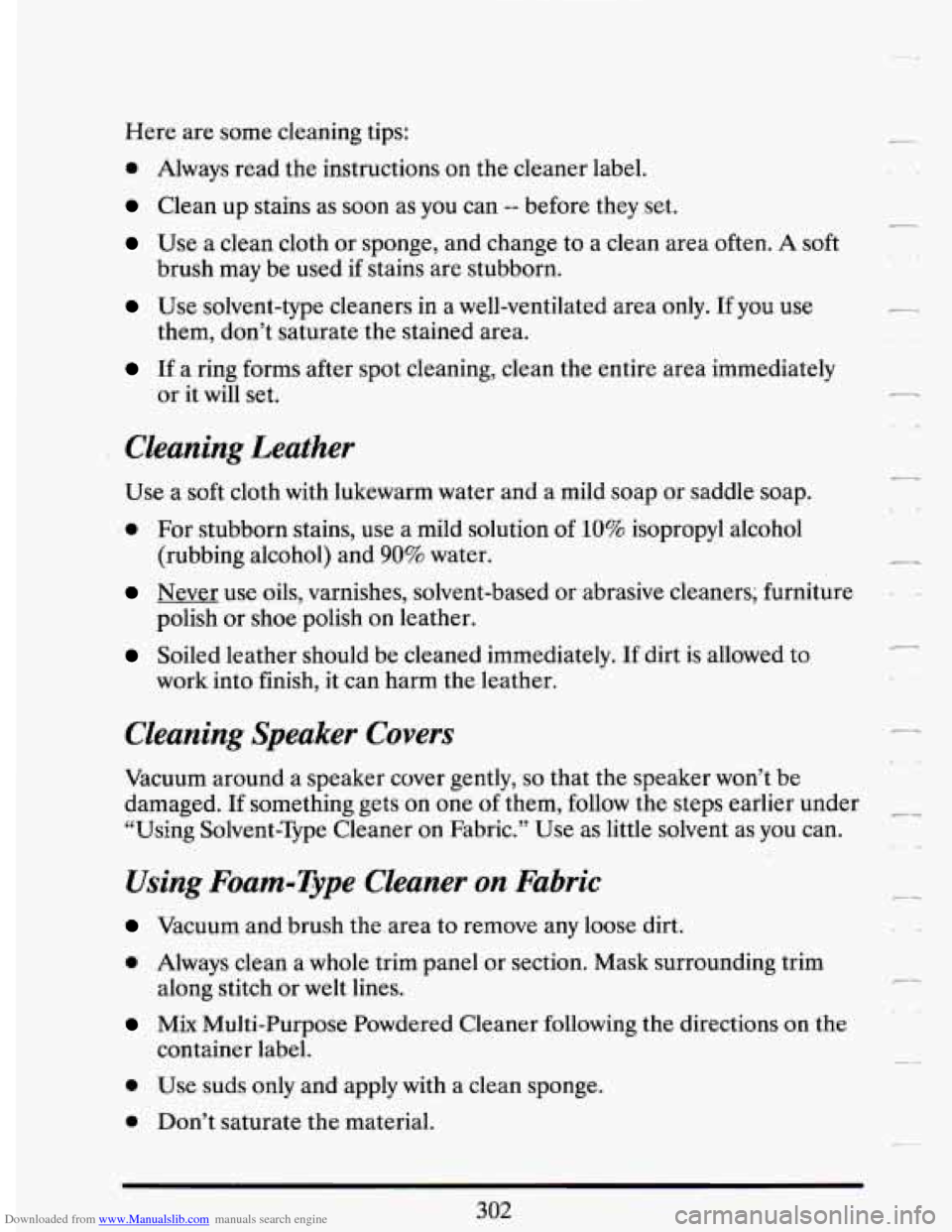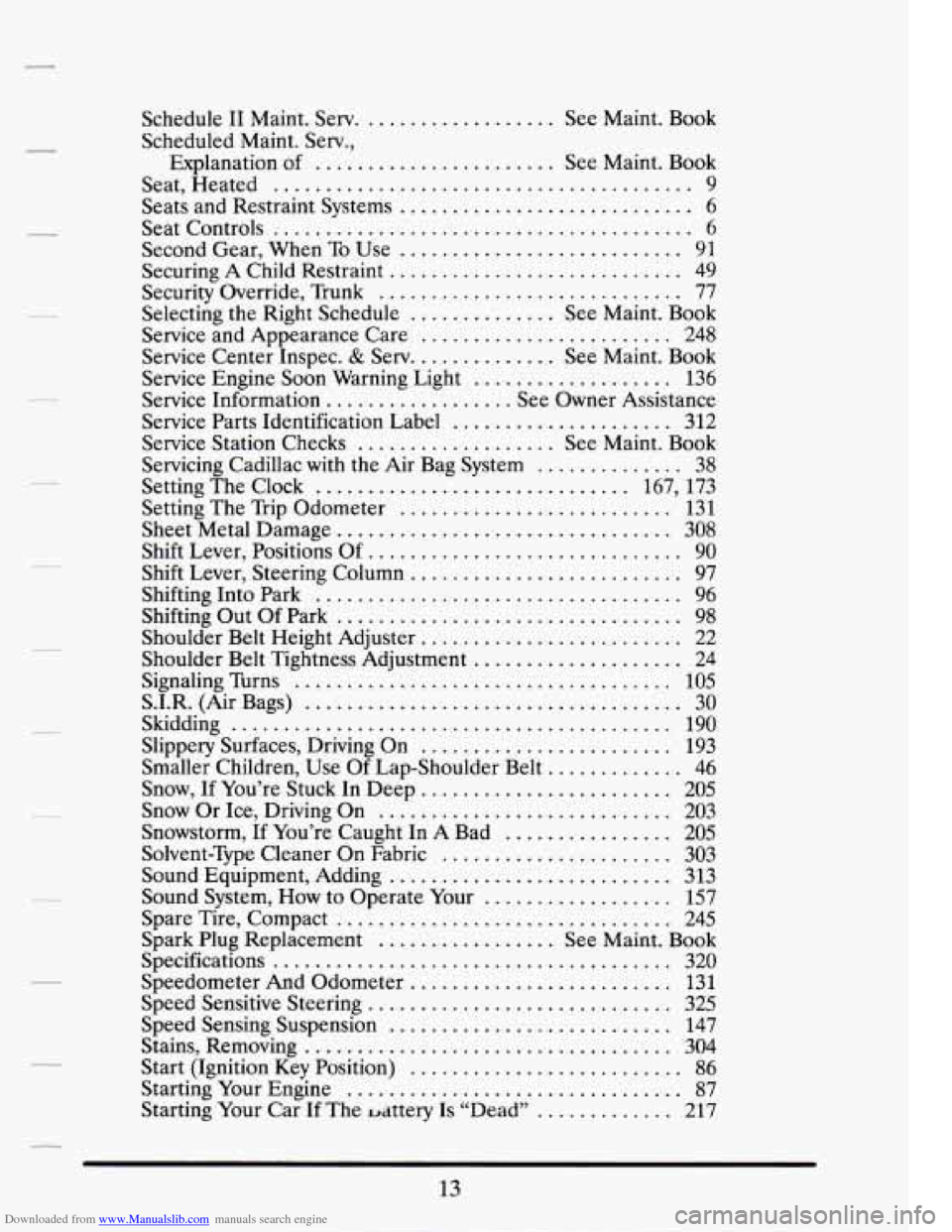tire type CADILLAC DEVILLE 1994 7.G Owners Manual
[x] Cancel search | Manufacturer: CADILLAC, Model Year: 1994, Model line: DEVILLE, Model: CADILLAC DEVILLE 1994 7.GPages: 399, PDF Size: 20.97 MB
Page 203 of 399

Downloaded from www.Manualslib.com manuals search engine LOSS OF CONTROL
Let’s review what driving experts say about what happens when the three
control systems (brakes, steering and acceleration) don’t have enough
friction where the tires meet the road to do what the driver has asked.
In any emergency, don’t give up. Keep trying to steer and constantly seek
an escape route or area of less danger.
Skidding
In a skid, a driver can lose control of the vehicle. Defensive drivers avoid
most skids by taking reasonable care suited to existing conditions, and by
not “overdriving” those conditions. But skids are always possible.
The three types of skids correspond to your Cadillac’s three control
systems. In the braking skid your wheels aren’t rolling. In the steering or
cornering skid, too much speed or steering in a curve causes tires to slip
and lose cornering force. And in
the acceleration skid too much throttle
causes the driving wheels to spin.
A cornering skid is best handled by easing your foot off the accelerator
pedal.
If you have the traction control system, remember: It helps avoid only the
acceleration skid.
If you do not have traction control, then an acceleration skid is also best
handled by easing your foot off the accelerator pedal.
If your vehicle starts to slide, ease your foot off the accelerator pedal and
quickly steer the way you want the vehicle to
go. If you start steering
quickly enough, your vehicle may straighten out. Always be ready for a
second skid if
it occurs.
Of course, traction is reduced when water, snow, ice, gravel, or other
material is on the road. For safety, you’ll want to slow down and adjust
your driving to these conditions. It is important to slow down
on slippery
surfaces because stopping distance will be longer and vehicle control
more limited.
c-
Page 223 of 399

Downloaded from www.Manualslib.com manuals search engine when you remove the hitch. If you don’t seal them, deadly carbon
monoxide
(CO) from your exhaust can get into your vehicle (see
Index under “Carbon Monoxide”). Dirt and water can, too.
attach rental hitches or other bumper-type hitches to them.
The bumpers on your vehicle are not intended for hitches. Do not
Safety Chains
You should always attach chains between your vehicle and your trailer.
Cross the safety chains under the tongue of the trailer so that the tongue
will not drop to the road
if it becomes separated from the hitch. Follow
the manufacturer’s recommendation for attaching safety chains. Always
leave just enough slack
so you can turn with your rig. And, never allow
safety chains to drag
on the ground.
Trailer Brakes
Be sure to read and follow the instructions for the trailer brakes so you’ll
be able to install, adjust and maintain them properly.
Driving with a Trailer
Towing a trailer requires a certain amount of experience. Before setting
out for the open road, you’ll want to get to
know your rig. Acquaint
yourself with the
feel of handling and braking with the added weight of
the trailer. And always keep
in mind that the vehicle you are driving is
now a good deal longer and not nearly
so responsive as your vehicle is by
itself.
Before you start, check the trailer hitch and platform, safety chains,
electrical connector, lights, tires and mirror adjustment. If the trailer has
electric brakes, start your vehicle and trailer moving and then apply the
trailer brake controller by hand to be sure the brakes are working. This
lets you check your electrical connection at the same time.
During your trip, check occasionally to be sure that the load is secure,
and that the lights and any trailer brakes are still working.
r
c.
.-
r.
Page 236 of 399

Downloaded from www.Manualslib.com manuals search engine 1. Sling Type
2. Wheel Lift
3. Car Carrier
If your vehicle has been changed or modified since it was factory-new by
adding aftermarket items like fog lamps, aero skirting, or special tires and
wheels, these instructions and illustrations may not be correct.
Before you do anything, turn on the hazard warning flashers.
When you call, tell the towing service:
That your vehicle cannot be towed from the front or rear with
That your vehicle has front-wheel drive.
The make, model, and year of your vehicle.
Whether you can still move the shift lever.
sling-type
equipment.
0 If there was an accident, what was damaged.
223
Page 306 of 399

Downloaded from www.Manualslib.com manuals search engine L
NOTICE:
Don’t let anyone tell you that underinflation or overinflation is
all right. It’s not.
If your tires don’t have enough air
(underinflation) you can get:
Too much flexing
Too much heat
Tire overloading
Bad wear
Bad handling
Bad fuel economy.
If your tires have too much air (overinflation), you can get:
Unusual wear
Bad handling
Rough ride
Needless damage from road hazards.
When to Check Check your tires once a month or more.
The tire pressures are:
Front - 30 psi (207 kPa)
Rear - 30 psi (207 kPa)
Recommended tire size
is:
Michelin XW4 Blackwall (P215/70R15)
T125/70RIS (Compact Spare)
c-
How to Check Use a good quality pocket-type gage to check tire
pressure. Simply looking at
the tires will not tell you the pressure,
especially
if you have radial tires -- which may look properly inflated even
if they’re underinflated.
293
Page 309 of 399

Downloaded from www.Manualslib.com manuals search engine The tire has a puncture, cut, or other damage that can’t be repaired
well because of the size or location of the damage.
Buying New Tires
To find out what kind and size of tires you need, look at the Tire-Loading
Information label.
The tires installed on your vehicle when it was new had a Tire
Performance Criteria Specification (TPC Spec) number
on each tire’s
sidewall. When you get
new tires, get ones with that same TPC Spec
number. That way, your vehicle
will continue to have tires that are
designed to give proper endurance, handling, speed rating, traction, ride
and other things during normal service on your vehicle.
If your tires have
an all-season tread design, the TPC number will be followed by a
“MS”
(for mud and snow).
If you ever replace your tires with those not having a TPC Spec number,
make sure they are the same size, load range, speed rating and
construction type (bias, bias-belted or radial) as your original tires.
Uniform Tire Quality Grading
The following information relates to the system developed by the United
States National Highway Traffic Safety Administration which grades tires
by treadwear, traction and temperature performance. (This applies only
to vehicles sold in the United States.)
Page 311 of 399

Downloaded from www.Manualslib.com manuals search engine While the tires ava.ilable as standard or optional equipment on General
Motors vehicles may vary with respect to these grades, all such tires
meet
General Motors performance standards and have been approved for use
on General Motors vehicles. All passenger type
(P Metric) tires must
conform to Federal safety requirements
in addition to these grades.
Wheel Alignment and Tire Balance
The wheels on your vehicle were aligned and balanced carefully at the
factory to give you the longest tire life and best overall performance.
In most cases, you
will not need to have your wheels aligned again.
However,
if you notice unusual tire wear or your vehicle pulling one way
or
the other, the alignment may need to be reset. If you notice your
vehicle vibrating when driving on a smooth road, your wheels may need
to be rebalanced.
Wheel Replacement
Replace any wheel that is bent, cracked or badly rusted. If wheel nuts
keep coming loose, the wheel, wheel bolts, and wheel nuts should be
replaced. If the wheel leaks air, replace
it (except some aluminum wheels,
which can sometimes be repaired). See your Cadillac dealer
if any of
these conditions exist.
Your dealer
will know the kind of wheel you need.
Each new wheel should have the same load carrying capacity, diameter,
width, offset, and be mounted the same way as
the one it replaces.
If you need to replace any of your wheels, wheel bolts, or wheel nuts,
replace them only with new GM original equipment parts. This way,
you
will be sure to have the right wheel, wheel bolts, and wheel nuts for your
Cadillac model.
298
Page 313 of 399

Downloaded from www.Manualslib.com manuals search engine Tire Chains
NOTICE:
Use tire chains only where legal and only when you must. Use
only
SAE Class “S” type chains that are the proper size for your
tires. Install them on the front tires and tighten them as tightly
as possible with the ends securely fastened. Drive slowly and
follow the chain manufacturer’s instructions.
If you can hear
the chains contacting your vehicle, stop and retighten them.
If
the contact continues, slow down until it stops. Driving too fast
with chains on
will damage your vehicle.
APPEGACE CARE
Remember, cleaning products can be hazardous. Some are toxic. Others
can burst into flame if you strike a match or get them on a hot part of the
vehicle. Some are dangerous
if you breathe their fumes in a closed space.
When
you use anything from a container to clean your Cadillac, be sure
to follow the manufacturer’s warnings and instructions.
And always open
your doors or windows
when you’re cleaning the inside.
300
Page 315 of 399

Downloaded from www.Manualslib.com manuals search engine Here are some cleaning tips:
Always read the instructions on the cleaner label.
Clean up stains as soon as you can -- before they set.
Use a clean cloth or sponge, and change to a clean area often. A soft
brush may be used
if stains are stubborn.
Use solvent-type cleaners in a well-ventilated area only. If you use
them, don’t saturate the stained area.
If a ring forms after spot cleaning, clean the entire area immediately
or it will set.
Cleming Leather
Use a soft cloth with lukewarm water and a mild soap or saddle soap.
For stubborn stains, use a mild solution of
10% isopropyl alcohol
(rubbing alcohol) and
90% water.
Never use oils, varnishes, solvent-based or-abrasive cleaners; furniture
Soiled leather should be cleaned immediately. If dirt is allowed to
polish or shoe polish on leather.
work into finish, it can harm the leather.
Cleaning Speaker Covers
Vacuum around a speaker cover gently, so that the speaker won’t be
damaged. If something gets.on one
of them, follow the steps earlier under
“Using Solv.ent-Type Cleaner on Fabric.’’ Use as little solvent as
you can.
Using Foam-Ppe Cleaner on Fabric
Vacuum and brush the.area to remove any loose dirt.
0 Always clean a whole trim panel or section. Mask surrounding trim
Mix Multi-Purpose Powdered Cleaner following the directions on the
along stitch
or welt lines.
container label.
IC-
7-.
0 Use suds only and apply with a clean sponge.
0 Don’t saturate the material.
Page 387 of 399

Downloaded from www.Manualslib.com manuals search engine Express Down Window (Driver’s Side) ................. 102
Expressway Driving ................................. 197
Extender. Safety Belt ................................ 64
Exterior Appearance ................................ 306
F
Fabric. Foam-Type Cleaner On ....................... 302
Fabric. Solvent-Type Cleaner On ...................... 303
Fasteners. Replacement ............................. 248
Features And Controls ............................... 66
Fetus. Risk To .. From Safety Belt Use .................. 39
Filling Your Fuel Tank .............................. 254
Finish Damage ..................................... 308
First Gear. When To Use ............................. 94
Flash-To-Pass Feature ............................... 106
Flat Tire
.......................................... 236
Flat Tire. Changing A ............................... 237
Flooded Engine. Starting A ........................... 87
Floor Mats ........................................ 130
Fluid
Brake .......................................... 276
Power Steering .................................. 273
Transaxle ....................................... 266
Windshield Washer .............................. 275
Fluid Capacities .................................... 328
Fluids & Lubricants. Recommended ........ See Maint . Book
Fluid Usage Label
.................................. 258
FM Stereo Radio Reception ......................... 157
Foam-Type Cleaner On Fabric ........................ 302
Fog: Getting It Off the Windshield .................... 154
Freeing Car From Sand. Mud. Ice or Snow ............. 247
French Language Manual ................. See Introduction
Front Seatbacks. Reclining
............................. 7
Fuel .............................................. 249
Fuel Data Panel .................................... 138
FuelEconomy ..................................... 251
Fuel Door. Remote ................................. 255
Fuel Tank. Filling Your .............................. 254
Fuels in Foreign Countries ........................... 251
Fuses And Circuit Breakers .......................... 314
Filter. Oil ......................................... 329
Francais. Guide En ...................... See Introduction
Freeway Driving
................................... 197
Fuel Gage ......................................... 137
Fuse Replacement .................................. 314
..
.
r .-,
.
-11
.
.
.
ri
6
Page 394 of 399

Downloaded from www.Manualslib.com manuals search engine .
.
.
.
.
.
.
.
.
.
.
.
Schedule I1 Maint . Serv ................... See Maint . Book
Scheduled Maint
. Serv.,
Explanation
of ....................... See Maint . Book
Seat. Heated
........................................ 9
Seats and Restraint Systems ............................ 6
Seat Controls ........................................ 6
Securing A Child Restraint ............................ 49
Security Override. Trunk ............................. 77
Service and Appearance Care ........................ 248
Service Center Inspec . & Serv .............. See Maint . Book
Service Engine Soon Warning Light
................... 136
Service Information .................. See Owner Assistance
Service Parts Identification Label
..................... 312
Service Station Checks ................... See Maint . Book
Servicing Cadillac with the Air Bag System
.............. 38
Setting The Clock .............................. 167. 173
Setting The Trip Odometer .......................... 131
Sheet Metal Damage ................................ 308
Shift Lever. Positions Of .............................. 90
Shift Lever. Steering Column .......................... 97
Shifting Into Park ................................... 96
Shifting Out Of Park ................................. 98
Shoulder Belt Height Adjuster ......................... 22
Shoulder Belt Tightness Adjustment .................... 24
Signaling Turns .................................... 105
S.I.R. (Air Bags) .................................... 30
Skidding .......................................... 190
Slippery Surfaces. Driving On ........................ 193
Smaller Children. Use Of Lap-Shoulder Belt ............. 46
Snow. If You’re Stuck In Deep ........................ 205
Snow Or Ice. Driving On ............................ 203
Snowstorm. If You’re Caught In A Bad ................ 205
Solvent-Type Cleaner On Fabric ...................... 303
Sound Equipment. Adding ........................... 313
Sound System. How to Operate Your .................. 157
Spare Tire. Compact ................................ 245
Spark Plug Replacement ................. See Maint . Book
Specifications ...................................... 320
Speedometer And Odometer ......................... 131
Speed Sensitive Steering ............................. 325
Speedsensing Suspension ........................... 147
Stains. Removing ................................... 304
Start (Ignition Key Position) .......................... 86
Starting Your Engine ................................ 87
Starting Your Car If The Uattery Is “Dead” ............. 217
Second Gear. When To Use ........................... 91
Selecting the Right Schedule .............. See Maint . Book
.
13